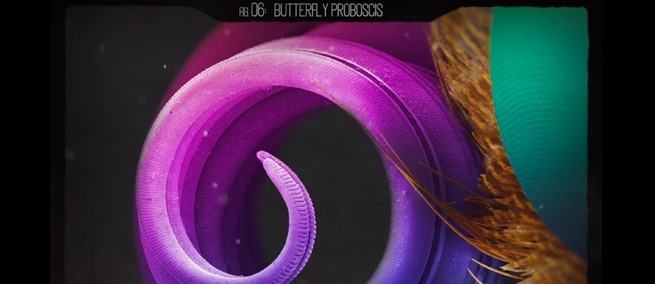
NON-LINEAR–A JOURNEY THROUGH TIME AND MICROCOSMIC SPACE provides a view of earth invisible to the naked human eye. Director Linnea Rundgren, a specialist in scientific imaging, used an electron microscope to capture fly feet, butterfly proboscis, mycelium, and more. She collaborated with poet Hugo Farrant, the film's co-director, on a narrative about evolution and life on earth. This six-minute film, which just won the Visual Science Award at the 2018 Imagine Science Film Festival, makes its online premiere on Sloan Science & Film and will be watchable here November 16 through December 14.
We spoke with Rundgren from her home in Sweden about the film.
Science & Film: How did your work in scientific imaging inform the way that you made this film?
Linnea Rundgren: The film is based on my work, which is sprung from my inspiration and my passion. Most of the images in the film are part of a scientific research project that I’ve been illustrating. I’ve been interested in science since forever, but with that has evolved this notion that there are underlying patterns that define everything that we can express through mathematics, verbally, or visually. [The patterns] are often geometric shapes, or they might be symmetrical or fractal, which is something the human mind responds to in a positive way. I’ve been fascinated by patterns and by the way things are.
S&F: Can you talk about the way you take the images?
LR: In this film, most of the images are taken with an electron microscope. I do a lot of my EM work at RMIT University in Melbourne and I’ve got another lab in Stockholm as well, which I’m working with. The electron microscope is essentially like a great big camera except it doesn’t use light, it uses electrons to record an image on the sensor. People use it to look at things but not necessarily with the intent to make awesome images. But I found when I was playing around with the microscope that you can use its parameters to adjust the image, similarly to how you would use the aperture and shutter speed on a camera, so depending on what voltage you use, or the distance to the sample, you get different effects and different surface detail. You can really manipulate a lot.
It has been a long process of experimenting. At times I have burned samples because I was using too high a voltage for the amount of coating for example. It’s also about how you treat the sample: if you put solid rock underneath the microscope it’s not going to look very exciting, but if you synthesize it and grow it then it could look amazing.
Ultimately I found that I mastered the understanding of how these things fit together and then I was served a platter of awesome tools to play with in this miniature realm.
S&F: It sounds like you spend a lot of time staging your shots.
LR: Oh my god, yeah. Preparation is key. That’s a big part of the process, preparing [the sample] and deciding how you’re going to position it. This can be a full day venture.
S&F: For the film, did you prepare all those samples in the same way?
LR: All different ways. The brain cells we had to grow from stem cells. We treated some of them with an amino acid that was inspiring a beta-amyloid plaque to grow so that we could observe the way that Alzheimer’s disease evolves as the cells are growing. It was part of an Alzheimer’s research project. It’s like we grew a brain in a little petri dish. Then it got gold-coated. So I guess that particular individual unfortunately died. It is a strange thing to think that there are a bunch of little brains that I grew. I wonder if they’re thinking about stuff. How bizarre.
NON-LINEAR is directed by Linnea Rundgren and Hugo Farrant, animated by Dave Abott, with music composed by Belgian electronic music pioneer Sk’p. Rundgren often works in collaboration with artists. Most recently, she made the background images for Children’s Book Of The Year Award-winner Do Not Lick This Book, by Idan Ben-Barak.
TOPICS